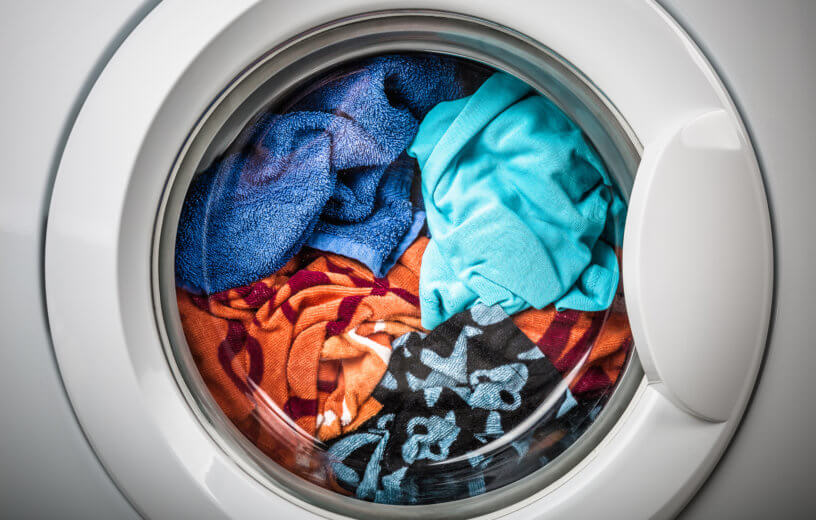BONN, Germany — In a finding that is sure to make germaphobes across the world double-check their laundry routines, researchers at the University of Bonn in Germany say antibiotic-resistant bacteria is capable of being spread by washing machines.
The discovery was made at a local children’s hospital in which a Klebsiella oxytoca pathogen was repeatedly being transmitted to newborns. While no dangerous infections actually presented themselves in the infants, an investigation into the matter revealed the source of transmission was a conventional washing machine being used at the hospital to clean the babies’ clothes.
Researchers say these findings are very significant, and illustrate the fact that antibiotic-resistant bacteria could just as easily spread via a washing machine being used in a residential home. Additional research is already being planned on the subject.
The Klebsiella oxytoca bacterium was being detected more and more often during routine hygiene screenings in the newborn ward of the hospital, so the hospital reported the matter to the Institute for Hygiene and Public Health (IHPH) of the University Hospital Bonn.
For reference, this particular type of bacterium is known to cause respiratory and gastrointestinal infections, and in worst case scenarios, fatal sepsis. The hospital tried using common antibiotics against the pathogens upon detection, but results were mixed at best.
“Luckily, these babies did not suffer any dangerous infections,” explains Dr. Daniel Exner, hygiene officer at the Clinic and Polyclinic for General, Visceral, Thoracic and Vascular Surgery at the University Hospital Bonn, in a release.
So, in order to trace back the source of transmission, environmental samples were collected from patient and staff areas, as well as locations considered to be “high risk.”
“This type of Klebsiella oxytoca was so unique that it was in this form not yet included in the database of the National Reference Center for gram-negative hospital pathogens,” comments Dr. Ricarda Schmithausen, Head of the One Health Department at IHPH.
This uniqueness described by Dr. Schmithausen actually helped the investigative team narrow down their search field; they were able to determine quickly that the pathogen was not being spread via the nursing staff or the infants’ parents. Eventually, the pathogen was traced back to the hospital washing machine.
“The Klebsiella oxytoca type was clearly identified in the detergent drawer and on the door seal of a washing machine in the basement, which was used to launder the hand-knitted socks and beanies of the babies on the ward,” says Dr. Martin Exner, Director of the Institute for Hygiene and Public Health at the University Hospital Bonn.
The bacteria was being spread to the infants via socks and beanies that had been in the washing machines. Once the washing machine had been disposed of, no additional detections were reported, effectively confirming that the transmission source had successfully been detected and eliminated.
It’s worth noting that researchers do not believe this is a common occurrence in hospitals. Modern hospitals usually use specialized washing machines that clean at high temperatures or just outsource their laundry needs to off-location laundromats. However, at this particular hospital, the staff were using a conventional washing machine on-site.
“We decided to investigate this case in order to draw attention to possible problems with resistant bacteria that are now advancing into the domestic environment,” Dr. Schmithausen comments.
This isn’t the first study to prove that antibiotic-resistant bacteria can take root inside washing machines, but it is the first to prove that a washing machine can then go on to spread the bacteria to humans.
Besides the groundbreaking impact these findings will have on a medical and scientific level, the study’s authors also say it has domestic implications. Most conventional household washing machines operate at temperatures well below 140 degrees Fahrenheit, which is generally a good thing considering it cuts back on energy usage and helps protect the environment. That being said, with these new bacterial revelations in mind, any household that includes an elderly individual receiving nursing care with open wounds or bladder catheters, or even younger people dealing with festering injuries or infections, should wash laundry at temperatures above 140 degrees Fahrenheit in order to ensure dangerous pathogens are not spread throughout the home.
The Institute for Hygiene and Public Health is already planning a more extensive study into the matter, and are currently looking for households containing individuals who have previously dealt with antibiotic-resistant bacteria willing to volunteer for future research.
The study is published in the scientific journal Applied and Environmental Microbiology.
